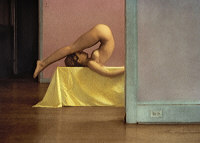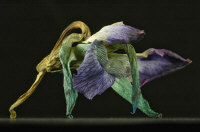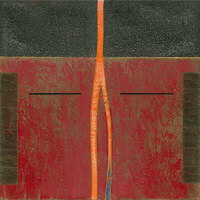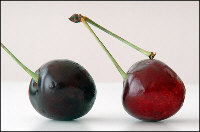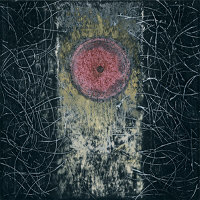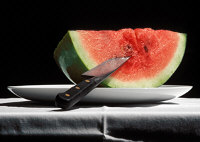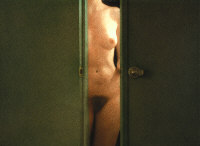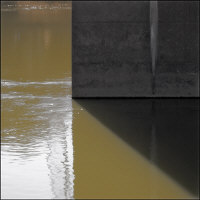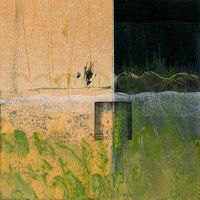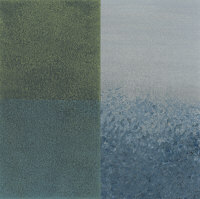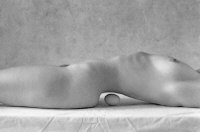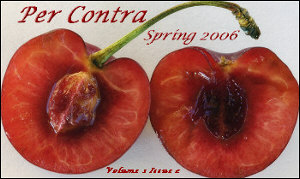
Peter Groesbeck, The Per Contra Interview by Miriam N. Kotzin
PC: When did you realize that art was going to be at the center of your lifeóassuming that if it isnít the center, itís close to the core?
PG: From the earliest I can remember, I was drawing. From first grade on, I felt the most comfortable in the art classes. Years later, I found my report card from my first grade class, with a comment on the back from the teacher: "Peter will probably grow up to be a great artist".
I didn't know how central art was going to be to me, but it resonated in my being the most. During my high school period, I was attending a preparatory seminary, with the intention of becoming a priest. In my freshman year, I did no art at all, and never even thought of its absence. But suddenly, in the beginning of sophomore year, I one day did an abstract drawing with pencil and ruler. From that point on, it was pretty much non-stop, much to the dismay of my teachers - this was a seminary, not an art school. But I couldn't cease. There was one priest there who realized my talent and interest. He arranged for me to go once a week to a local women's college to attend an art class. This was actually one of the nun's there giving me a personal art class every week. She had me doing watercolors, painting, drawing, even pottery.
PC: Where did you get your professional training? Were any teachers particularly influential on you, and if so who? Influential artists?
PG: I received my formal training at the Pennsylvania Academy of the Fine Arts in Philadelphia. There were several teachers there who were helpful to me. Elizabeth Osborne, Joseph Amarotico, Jimmy Leuders, and Dan Smith were very encouraging of my work. The artists I was interested in at the time were a diverse group, for diverse reasons: Magritte, Hopper, Balthus, Fra Angelico, Tiepolo, Mantegna, Della Francesca, the Abstract Expressionists, Ernst, Boucher, Fragonard.
PC: Did you start as a painter or a photographer?
PG: I started as a painter, my interest primarily being in art. I started photography during my third year at the Academy, in 1973, due to the fact that I was working in the conservation lab at the Academy, and one of the necessities of the conservation process was photographing the various stages of the work. The conservator at the time, Joseph Amarotico, asked me if I knew how to use a camera. When I replied no, he said "it's simple, I'll teach you in five minutes" Thus began my photographic career.
PC: Do you go through periods where one takes ascendancy over the other?
PG: Art and photography have since continued together to be ways to express myself. They fluctuate back and forth - sometimes more painting the photos, sometimes reverse. I find that they compliment each other quite well. Although I don't directly work from photos, I find that things that I photograph very often reflect the sensibility of what is occurring in my painting at the same time.
PC: How do you see them as related to one another?
PG: They are related to one another in the fact that they both help me to be able to express my vision of the world, and life. I like the photographic process, because I end up with an image that is 'real' -seemingly easily read and understood, even if an abstract composition. My painting, on the other hand, is perfect for me to express non-verbal images. They are my true language, which I understand thoroughly.
PC: Your photography is of several sorts: would you call your series of close ups of fruit and flowers still lifes? Youíve done landscapes, cityscapes?
PG: I usually consider my photos of still lifes to be portraits, and also, in their own way, architectural shots. The closer I get, and the smaller the area I photograph, the more monumental and architectural they become. My photos of cities are often views of the 'forgotten' spaces in our cities. Views that are always before us, but almost completely ignored. But my thought in taking photos of them is precisely to increase our awareness of such places. They are 'designed', even in their randomness, and we are surrounded by them. My interest is how they wend their way into our subconscious, and therefore how we are affected by them.
PC: Sometimes you color your photographs, which is reminiscent of the old photographers, Nutting and others, but ends up quite different. I know thereís a resurgence of photographers working like this, tinting black and white or sepia. When you do it, how do you work? What decisions do you make? For example, do you start with a black and white image and then color it or color, make it black and white, and then add color? Do you hand tint or use a computer?
PG: My interest in hand coloring photos was generated by watching my father, an amateur photographer, hand color family photos. The process available today is virtually the same one he used. I start with a black and white print, sepia tone it, and then add color by using photo oils. The color is applied with cotton swabs, q-tips, and sometimes brushes or pencils. My intention in starting to hand color prints was also generated by my dissatisfaction with commercial color prints. They were always over saturated and 'bright and happy' colors. Unable and unwilling to set up my own color lab, I was continually frustrated by receiving color prints from labs. Hand coloring the prints enabled me to achieve the color I wished. In recent years, even though the photo oils are still available, the commercial papers have changed substantially. They are no longer silver saturated, and the surfaces of the papers I used have changed radically, so that I can no longer obtain the same results.
PC: Do you do digital photography? What sort of printing?
PG: I have recently been working more and more with Photoshop with my images, and find that I can finally, through the wonderful filters and adjustments available in Photoshop, adjust the color of a print to be exactly what I envisioned it to be, and more so. I have begun to also 'hand color' a few, by overlaying color with layer masks.
PC: How does living in the city influence your work? Does it go beyond subject matter?
PG: The city influences my work in a subconscious way. Years ago, when I was painting in a real/surreal manner, I found myself painting interiors with an exterior view of just a sliver of sky, or building. My present work, though abstract, often still reflects the idea of a central core, post or sliver of information. This comes from almost always never having a full view of the sky in the city; only fragments of the realization of sky/land are visible.
PC: Youíve mentioned the role of accident in your work. Will you share a photograph or two that shows that in play? How did it come about? Iím thinking both of the bridge photo that ended up looking like one of your paintings and the long narrow photomontage of the flower. Can you think of others, or were these flukes?
PG: Accidents are almost always beneficial and revelatory. In my painting this often leads to a new step or stage, and helps me to see a new tactic, or possible use of a different design or color. In my photographs, I often will see something, take the shot, and then only when I view it realize that again subconsciously I saw something within the shot that resonates beautifully. I trust these moments, because I feel when they happen that "I" have stepped aside, and that it is then that I am truly "connected'.
PC: You work as a graphic artist for Drexel University. Itís clear that you bring your talent and skill to the postersóbut does the graphic design do anything positive for your other work? What?
PG: My graphic art work for Drexel is beneficial to my personal work. I don't draw a line, or minimize my creativity between the two. It is always a seeking process, and things that happen creatively while working on a poster for Drexel might influence the next photo or painting, and vice-versa.
Images on the right may be viewed at a larger size by clicking on the individual image.
Issue 2
Paintings and Photographs by Peter Groesbeck
Click Image for Full-Sized View
Liz
Orchid
Feminal
Cherries in Love
Cherry Pit (cover)
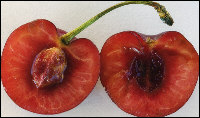
Journey
Watermelon
Door/Torso
Bridge
Relinquishing My Dreams
Want
Egg/Torso
Apple Core
